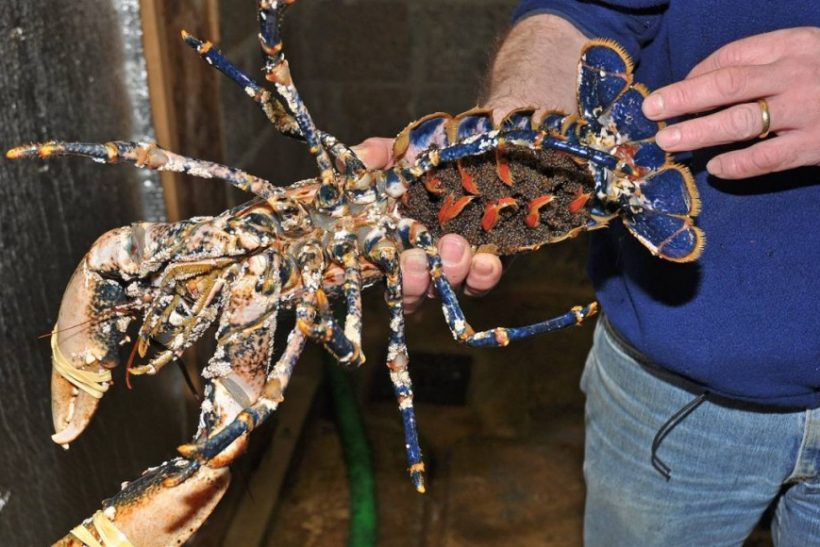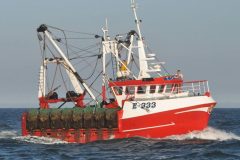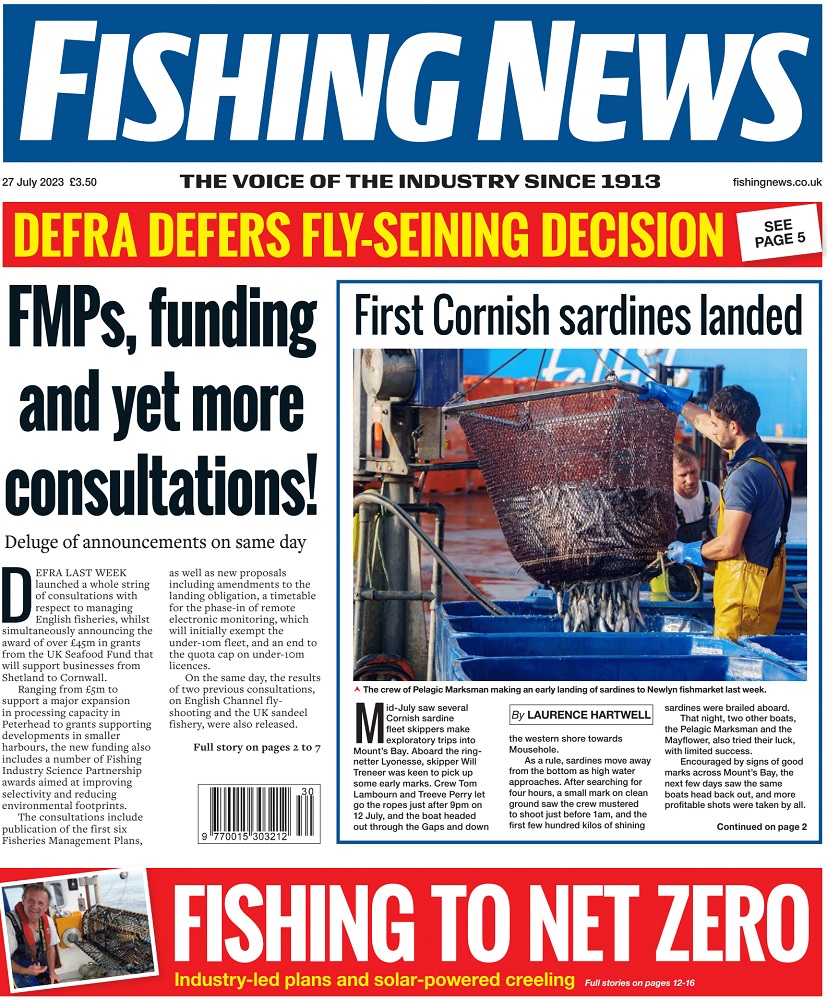Here is the second part of our three part feature on commercial fishing in Orkney by David Linkie. You can read the first part of this feature here.
Lamb Holm lobster hatchery makes vital contribution to stock levels
Although not always incremental, and always weather related, lobster catches in Orkney exhibit a generally upward trend.
Above: Hatchery manager Dawson Shearer displays a female lobster that has started to release eggs in the brood room.
146t of lobsters were landed in Orkney in 2014, compared to 88t in 2000, and 132t last year. With a catch value of £1.5m, this rise in catch rates, which has also included a few troughs, replaces what was a predominately downward pattern in the late 1990s. Clearly this evolving pattern is welcome news for creel fishermen in Orkney, most of whom rely on a seasonal mixed fishery that revolves around lobster, brown and velvet crab.
There is little doubt that this improvement in lobster catches is directly attributable to the proactive stock enhancement programme achieved by the Orkney lobster hatchery at Lamb Holm, from where up to 60,000 juvenile lobsters can be reared and released into the sea annually.
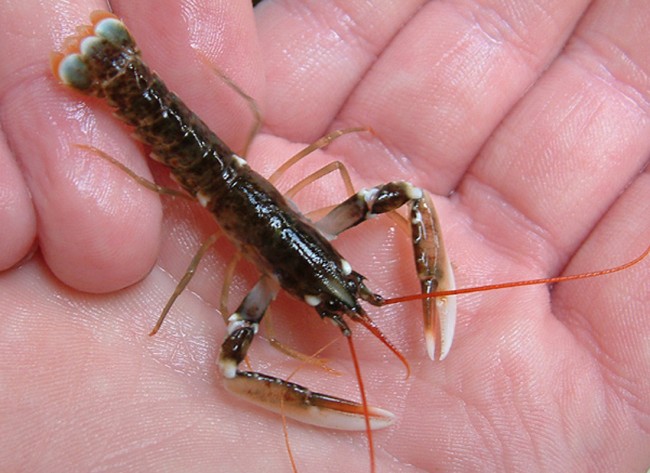
Mission accomplished – a stage-7 juvenile lobster ready for release in to the sea to provide sustainable catch levels in years to come.
Recent years have seen a return to a more traditional autumn lobster fishery, partly because crews are staying away from known grounds in the spring and early summer months in order to realise better returns as market demand strengthens after the customary mid-year low point.
Established by North Isles Shellfish in 1996, management of the lobster hatchery was subsequently taken over by the Orkney Fishermen’s Association, which received financial support from Orkney Islands Council, Orkney Enterprise, the SFF Fishermen’s Trust and the EU.
The hatchery was rebuilt in 2002, and through its innovative design has become the most successful lobster hatchery in Europe. In 2006 Orkney Sustainable Fisheries Ltd, took over the management and funding of the commercially-run hatchery.
The hatchery ‘borrow’ berried lobsters from O-Fish-Shell for storage in a 72-box hen incubation room. Up to 30,000 larvae can accumulate in storage tanks overnight. Each morning some of these larvae are transferred into the conical room and aerated seawater water held at 22°C, while the remainder are released back into the sea. The lobster larvae rapidly develop through four moults, before free-swimming juvenile lobsters, by now carrying their claws in front, are individually scooped out for transfer to the next stage, where they are stored individually.
In the past few years the hatchery team has developed innovations in bio-filtration and re-circulation technology to enhance output.
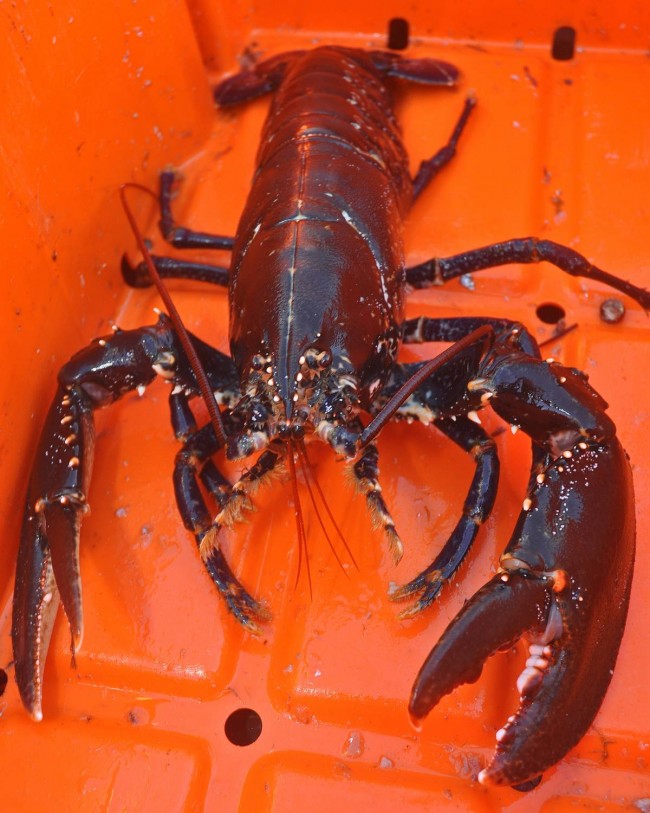
A good sized lobster that could have started life in the Lamb Holm hatchery.
Another recent development is the design of an innovative new lobster ‘Aquahive’ storage system for stage 6-7 juvenile (25-45mm) lobsters grown-on individually in the post-larval rearing room. The compact nature of the Aquahive unit has resulted in the hatchery doubling its storage capacity during the main May-November production period.
When fully operational, multi-stack aquahives, which replace the previously used individual square containers, have the potential to produce nearly a million juvenile lobsters per season, rather than tens of thousands. This is the only way to break the perception that fishery restocking can only be of limited impact due to the relatively high cost of producing lobster juveniles in hatcheries.
During the peak summer season, the hatchery manager Dawson Shearer and his team typically select 1,000 stage-4 lobsters for placement in the Aquahive storage trays for two weeks, from where they are released as stage 5-6 lobsters. Juvenile lobsters are usually released in 3-10 fathoms of water, all round Orkney, including Westray, Stronsay, Sanday, Hoy, Burray, South Ronaldsay, Scapa Flow and all parts of the mainland. The Orkney hatchery has released well in excess of 700,000 juvenile lobsters into local waters since 1998, which research carried out by Seafish indicates a 40% return.
Working closely with hatchery staff, Orkney static-gear fishermen continue to release juvenile lobsters as part of their normal working day, enabling fishermen to further increase their confidence in this method of stock enhancement.
Orkney Fishermen’s Society delivers advanced crab processing
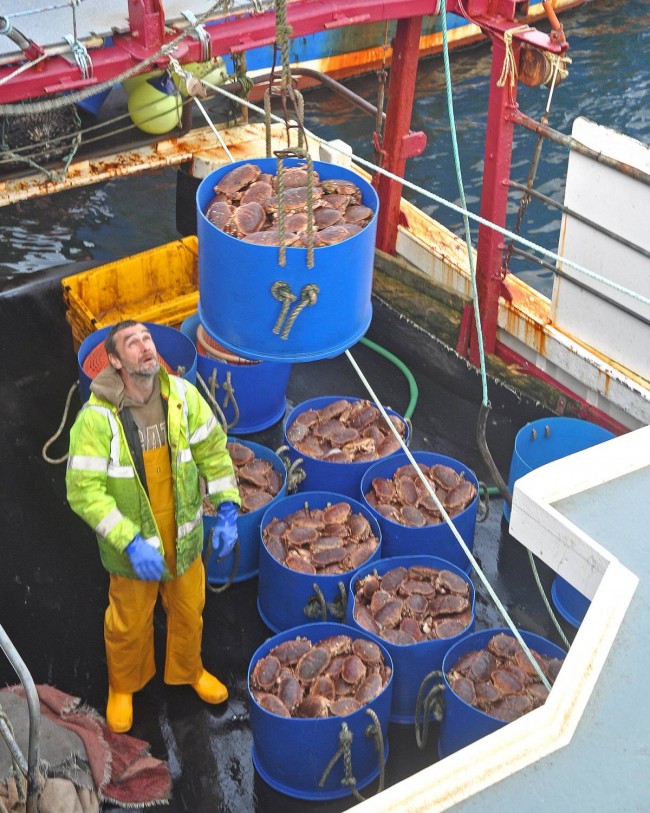
Eoin Sinclair’s Shalimar landing brown crab at Stromness to OFS.
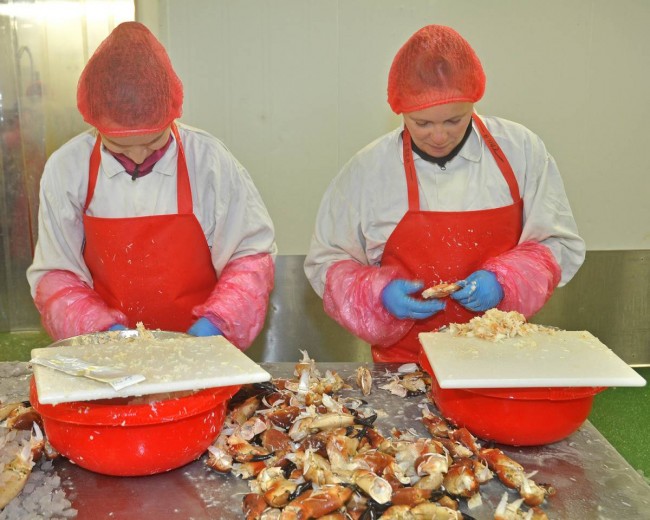
Hand-picking claws.
Continually investing in the latest state-of-the-art crab processing equipment is enabling Orkney Fishermen’s Society (OFS) to increase its production, and develop new added-value products and marketing opportunities worldwide.
OFS is widely recognised as one of the top dedicated crab processors in Europe and has significant growth opportunities in both the UK and abroad.
Brown crab caught by the Orkney shellfish fleet, and processed in the OFS factory at Stromness, is just as likely to be bought off the shelves of such well-known UK supermarket operators as Waitrose, Marks and Spencer, Sainsbury and Tesco, as it is to be exported to the Far East and Scandinavia.
Crabmeat from the OFS factory is sold to companies that specialise in producing value-added food products for leading supermarket outlets in Britain and Europe.
The innovative, wide range of resulting value-added products includes crab bakes, gratins, linguine, mousses and platters, in addition to a variety of crab claw products and dressed crab.
This extremely broad customer base provides vital marketing continuity and stability for some 40 locally-owned Orkney crab boats, which range from under- 10m vessels fishing close inshore, to modern vivier-crabbers, of which some of the bigger vessels, such as the Birsay-owned Celtic Dawn II and Nórønya, can fish up to 100 miles west of Orkney.
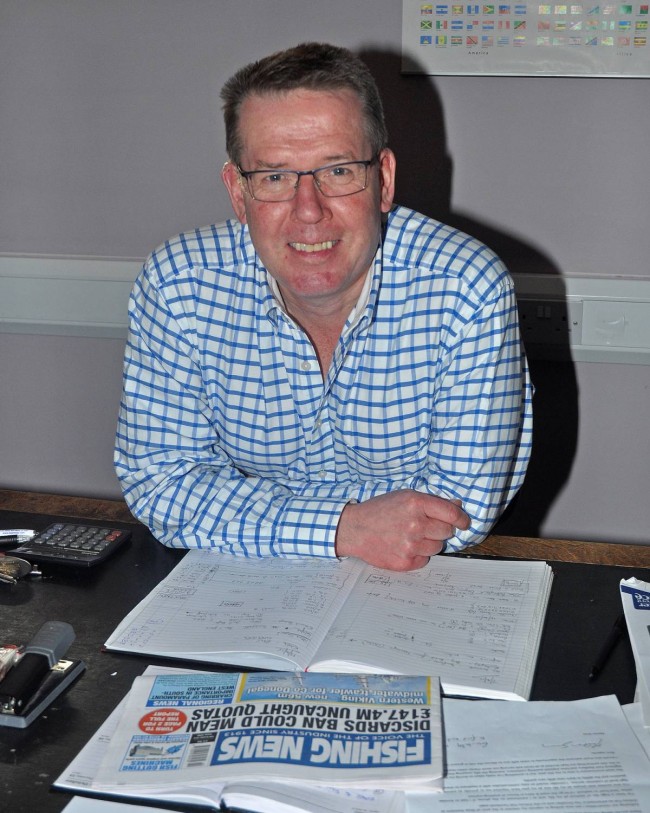
Stewart Crichton MD OFS.
Since being built in 1996, the crab processing factory at Stromness, run by Orkney Fishermen’s Society, itself established in 1953 by local creel fishermen initially to market live lobsters, has gone from strength to strength to become firmly established as one of the largest producers of crab meat in Europe. With a staff of 120 the OFS crab factory is the biggest single employer in Stromness.
A large number of Orkney fishermen are shareholders in the processing factory, while some are members of the management committee.
In its first year of operation, the Stromness factory handled 200 tonnes of crab. 20 years on, during which time over £5m has been invested in the factory and modern processing equipment, the annual throughput is in the region of 2,500 tonnes – an outstanding achievement and one that managing director Stewart Crichton, the factory staff and OFS are justifiably proud of, although not complacent about.
In addition to quayside access to freshly-caught top quality brown crab, one of the key reasons for the success achieved by OFS is the ongoing investment in new processing machinery which includes a US manufactured continuous automated crab cooking plant and a humane shellfish stunner.
An X-ray machine, used to identify any shell present in processed crabmeat, is another example of hi-tech equipment which OFS has invested in, to develop niche markets in the UK, as well as China, Singapore and Scandinavia.
OFS also operates a purpose-built 400-pallet cold store building, which, including purpose-built office accommodation, is situated within 100m of the Stromness processing factory and the popular Orkney Fish retail shop, from which a seafood sandwich van provides further marketing opportunities.
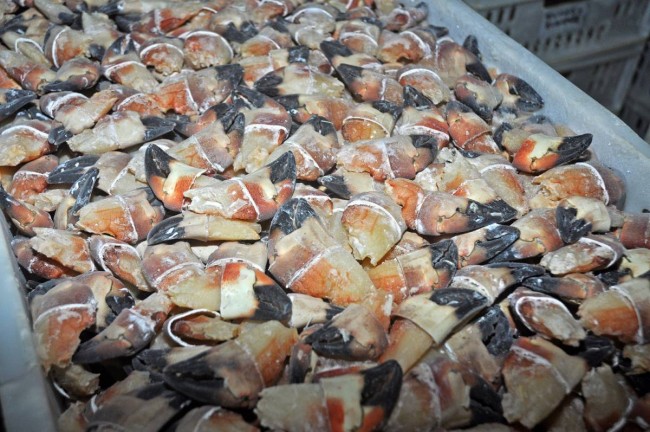
Cut crab claws are always popular.
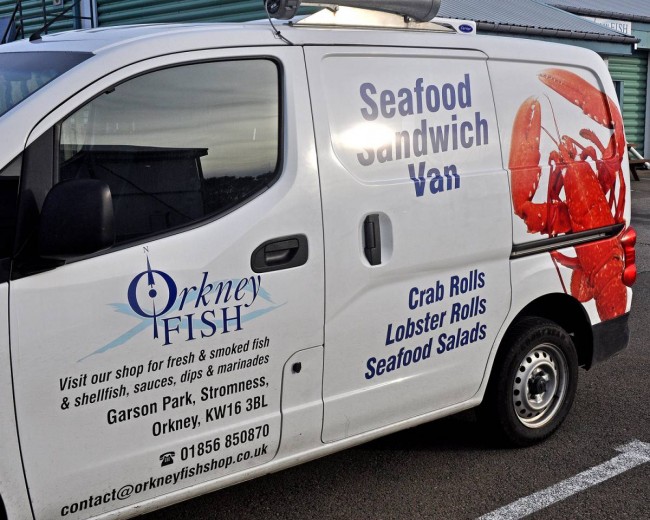
The Orkney Fish seafood sandwich van is a frequent and popular sight on Orkney.
With shellfish storage tanks strategically situated on Stromness pier, OFS also caters for the live market.
Last year shellfish valued in excess of £1.5m, mainly lobster and velvet crab landed by local boats, were packed and dispatched by OFS for export to Europe.
For a variety of reasons, including the continuing ban of live exports to China, an oversupply of crab claws and an inclement summer in Britain that resulted in lower than average sales in the UK retail sector – associated with reduced demand for seafood salads – 2015 was a fairly challenging year in relation to marketing brown crab. However, Stewart Crichton is relatively upbeat and confident about future market opportunities.
The power of thirteen

The whitefish trawler Aalskere is one of a large number of Orkney boats on which the registration numbers give the mystical total of 13, which Orkney skippers consider to be a good luck omen.
While many people treat the number 13 with caution at best, Orkney skippers consider it to be a good luck omen for the registration numbers of their vessels to total 13.
It is no surprise therefore to see that a higher than expected number of K (Kirkwall) registrations add up to 13, with as many combinations of suitable digits being used as possible.
Ranging from all the biggest whitefish trawlers in the Orkney fleet to inshore creel boats, the list of vessels with registration numbers related to this local preference includes Aalskere K 373, Álsviør K 337, Celtic Dawn II K 76, Illustrious K 616, Keila K 121 (12+1), New Venture K 112 (11+2), Queline K 1138, Russa Taign K 193, Samantha Jane K 94, Shalimar K 49 and Shaunette K 157.
* At the opposite end of Britain, registration numbers totalling 10 are favoured by Brixham skippers.
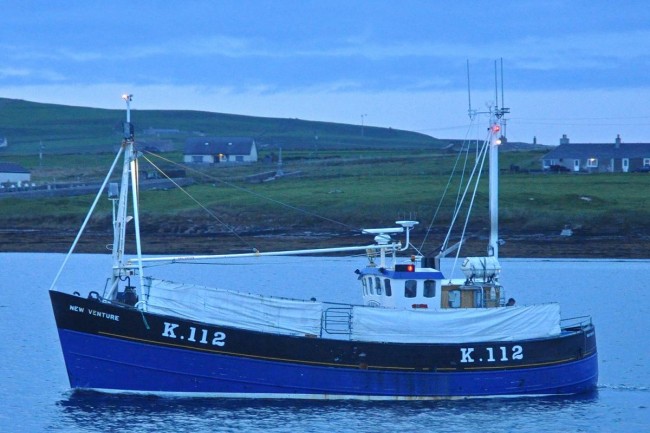
Young Westray skippers Adam and Paul Tulloch selected the registration number of K 112 (11+2) for their crabber New Venture.
Orkney brown crab in assessment for Protected Name Status
Orkney brown crab is currently in the final stages of assessment for the highly-prized Protected Name Status; a process which Scottish Fisheries Minister Richard Lochhead announced at the Inshore Fisheries Conference in Inverness three months ago.
Being awarded Protected Name Status will further enhance the already high reputation and standing of Orkney brown crab that, by accounting for nearly 50% of the annual catch value, is extremely important to local fishermen.
A successful outcome to the assessment process will help to develop and drive sales forward, for the long-term benefit of Orcadian crab fishermen.
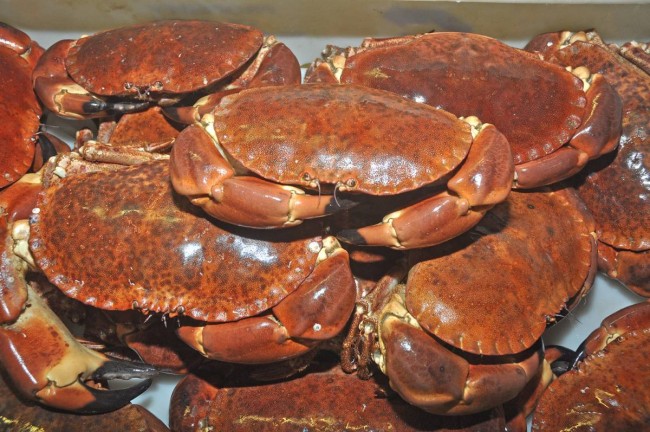
Orkney brown crab is currently being assessed for Protected Name status…
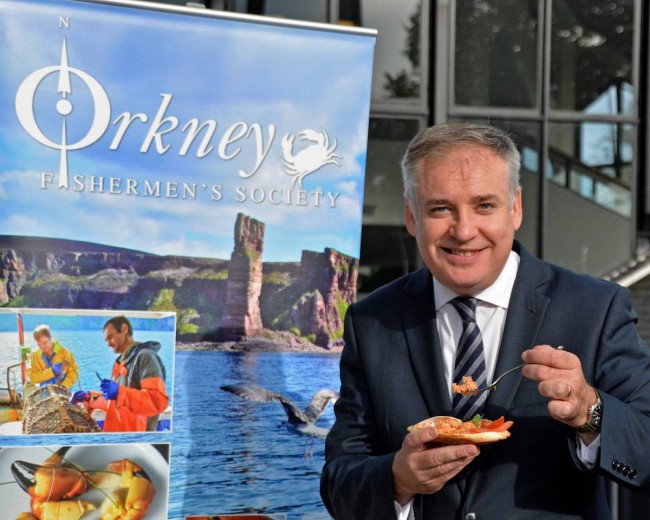
… after the initiative was announced by Scottish Fisheries Minister Richard Lochhead at the SIFC.
Orkney Sustainable Fisheries Ltd
Orkney Sustainable Fisheries Ltd (OSF) is a not-for-profit organisation that was established in 2006 to run the local lobster hatchery at Lamb Holm, and to take forward various initiatives relating to the future of Orkney’s vitally-important inshore fisheries.
The current chairman is Stewart Crichton, MD of Orkney Fishermen’s Society.
In September 2009, Orkney became the first area in the UK to appoint a dedicated Shellfish Sustainability Officer.
Local shellfish research has continued to grow, and OSF now employs three dedicated shellfish researchers, Kate Rydzowski, Matt Coleman and Beta Rodrigues.
Their ongoing work is supported on a scientific level by Dr Mike Bell of Heriot-Watt University’s Orkney Campus. The team has just begun the final year of a 4-year fishery improvement project, supported by Marks and Spencer, Orkney Islands’ Council and the local fishery. This project aims to have the fishery meeting MSC criteria by the end of 2016.
Alongside this major piece of work there are a number of further research projects being currently run:
- Developing and researching habitats for juvenile lobsters
- Tagging and monitoring movement of juvenile scallops
- Monitoring of bottom sea temperatures in relation to crustacean catches
- Tagging and monitoring migratory movements of brown crab
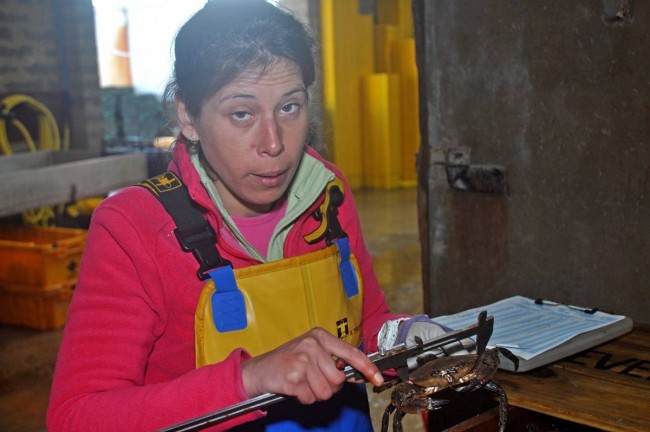
OSF shellfish researcher Beth Rodrigues gathering data on velvet crabs.
Orkney Fishermen’s Society takes the view that the marine environment is going to come under increased pressure from other potential users, including marine energy, aquaculture and marine protected areas – and that all these may have an impact on the traditional inshore fisheries of the area.
The final part of this three part feature will be available shortly. Read more from Fishing News here.


Here is the second part of our three part feature on commercial fishing in Orkney by David Linkie. You can read the first part of this feature here. Lamb Holm lobster hatchery makes vital contribution to stock levels
Although not always incremental, and always weather related, lobster catches in Orkney exhibit a generally upward trend.
Above: Hatchery manager Dawson Shearer displays a female lobster that has started to release eggs in the brood room.
146t of lobsters were landed in Orkney in 2014, compared to 88t in 2000, and 132t last year. With a catch value of £1.5m, this rise in catch rates, which has also included a few troughs, replaces what was a predominately downward pattern in the late 1990s. Clearly this evolving pattern is welcome news for creel fishermen in Orkney, most of whom rely on a seasonal mixed fishery that revolves around lobster, brown and velvet crab.
There is little doubt that this improvement in lobster catches is directly attributable to the proactive stock enhancement programme achieved by the Orkney lobster hatchery at Lamb Holm, from where up to 60,000 juvenile lobsters can be reared and released into the sea annually.

Mission accomplished – a stage-7 juvenile lobster ready for release in to the sea to provide sustainable catch levels in years to come.
Recent years have seen a return to a more traditional autumn lobster fishery, partly because crews are staying away from known grounds in the spring and early summer months in order to realise better returns as market demand strengthens after the customary mid-year low point.
Established by North Isles Shellfish in 1996, management of the lobster hatchery was subsequently taken over by the Orkney Fishermen’s Association, which received financial support from Orkney Islands Council, Orkney Enterprise, the SFF Fishermen’s Trust and the EU.
The hatchery was rebuilt in 2002, and through its innovative design has become the most successful lobster hatchery in Europe. In 2006 Orkney Sustainable Fisheries Ltd, took over the management and funding of the commercially-run hatchery.
The hatchery ‘borrow’ berried lobsters from O-Fish-Shell for storage in a 72-box hen incubation room. Up to 30,000 larvae can accumulate in storage tanks overnight. Each morning some of these larvae are transferred into the conical room and aerated seawater water held at 22°C, while the remainder are released back into the sea. The lobster larvae rapidly develop through four moults, before free-swimming juvenile lobsters, by now carrying their claws in front, are individually scooped out for transfer to the next stage, where they are stored individually.
In the past few years the hatchery team has developed innovations in bio-filtration and re-circulation technology to enhance output.

A good sized lobster that could have started life in the Lamb Holm hatchery.
Another recent development is the design of an innovative new lobster ‘Aquahive’ storage system for stage 6-7 juvenile (25-45mm) lobsters grown-on individually in the post-larval rearing room. The compact nature of the Aquahive unit has resulted in the hatchery doubling its storage capacity during the main May-November production period.
When fully operational, multi-stack aquahives, which replace the previously used individual square containers, have the potential to produce nearly a million juvenile lobsters per season, rather than tens of thousands. This is the only way to break the perception that fishery restocking can only be of limited impact due to the relatively high cost of producing lobster juveniles in hatcheries.
During the peak summer season, the hatchery manager Dawson Shearer and his team typically select 1,000 stage-4 lobsters for placement in the Aquahive storage trays for two weeks, from where they are released as stage 5-6 lobsters. Juvenile lobsters are usually released in 3-10 fathoms of water, all round Orkney, including Westray, Stronsay, Sanday, Hoy, Burray, South Ronaldsay, Scapa Flow and all parts of the mainland. The Orkney hatchery has released well in excess of 700,000 juvenile lobsters into local waters since 1998, which research carried out by Seafish indicates a 40% return.
Working closely with hatchery staff, Orkney static-gear fishermen continue to release juvenile lobsters as part of their normal working day, enabling fishermen to further increase their confidence in this method of stock enhancement.
Orkney Fishermen’s Society delivers advanced crab processing

Eoin Sinclair’s Shalimar landing brown crab at Stromness to OFS.

Hand-picking claws.
Continually investing in the latest state-of-the-art crab processing equipment is enabling Orkney Fishermen’s Society (OFS) to increase its production, and develop new added-value products and marketing opportunities worldwide.
OFS is widely recognised as one of the top dedicated crab processors in Europe and has significant growth opportunities in both the UK and abroad.
Brown crab caught by the Orkney shellfish fleet, and processed in the OFS factory at Stromness, is just as likely to be bought off the shelves of such well-known UK supermarket operators as Waitrose, Marks and Spencer, Sainsbury and Tesco, as it is to be exported to the Far East and Scandinavia.
Crabmeat from the OFS factory is sold to companies that specialise in producing value-added food products for leading supermarket outlets in Britain and Europe.
The innovative, wide range of resulting value-added products includes crab bakes, gratins, linguine, mousses and platters, in addition to a variety of crab claw products and dressed crab.
This extremely broad customer base provides vital marketing continuity and stability for some 40 locally-owned Orkney crab boats, which range from under- 10m vessels fishing close inshore, to modern vivier-crabbers, of which some of the bigger vessels, such as the Birsay-owned Celtic Dawn II and Nórønya, can fish up to 100 miles west of Orkney.

Stewart Crichton MD OFS.
Since being built in 1996, the crab processing factory at Stromness, run by Orkney Fishermen’s Society, itself established in 1953 by local creel fishermen initially to market live lobsters, has gone from strength to strength to become firmly established as one of the largest producers of crab meat in Europe. With a staff of 120 the OFS crab factory is the biggest single employer in Stromness.
A large number of Orkney fishermen are shareholders in the processing factory, while some are members of the management committee.
In its first year of operation, the Stromness factory handled 200 tonnes of crab. 20 years on, during which time over £5m has been invested in the factory and modern processing equipment, the annual throughput is in the region of 2,500 tonnes – an outstanding achievement and one that managing director Stewart Crichton, the factory staff and OFS are justifiably proud of, although not complacent about.
In addition to quayside access to freshly-caught top quality brown crab, one of the key reasons for the success achieved by OFS is the ongoing investment in new processing machinery which includes a US manufactured continuous automated crab cooking plant and a humane shellfish stunner.
An X-ray machine, used to identify any shell present in processed crabmeat, is another example of hi-tech equipment which OFS has invested in, to develop niche markets in the UK, as well as China, Singapore and Scandinavia.
OFS also operates a purpose-built 400-pallet cold store building, which, including purpose-built office accommodation, is situated within 100m of the Stromness processing factory and the popular Orkney Fish retail shop, from which a seafood sandwich van provides further marketing opportunities.

Cut crab claws are always popular.

The Orkney Fish seafood sandwich van is a frequent and popular sight on Orkney.
With shellfish storage tanks strategically situated on Stromness pier, OFS also caters for the live market.
Last year shellfish valued in excess of £1.5m, mainly lobster and velvet crab landed by local boats, were packed and dispatched by OFS for export to Europe.
For a variety of reasons, including the continuing ban of live exports to China, an oversupply of crab claws and an inclement summer in Britain that resulted in lower than average sales in the UK retail sector – associated with reduced demand for seafood salads – 2015 was a fairly challenging year in relation to marketing brown crab. However, Stewart Crichton is relatively upbeat and confident about future market opportunities.
The power of thirteen

The whitefish trawler Aalskere is one of a large number of Orkney boats on which the registration numbers give the mystical total of 13, which Orkney skippers consider to be a good luck omen.
While many people treat the number 13 with caution at best, Orkney skippers consider it to be a good luck omen for the registration numbers of their vessels to total 13.
It is no surprise therefore to see that a higher than expected number of K (Kirkwall) registrations add up to 13, with as many combinations of suitable digits being used as possible.
Ranging from all the biggest whitefish trawlers in the Orkney fleet to inshore creel boats, the list of vessels with registration numbers related to this local preference includes Aalskere K 373, Álsviør K 337, Celtic Dawn II K 76, Illustrious K 616, Keila K 121 (12+1), New Venture K 112 (11+2), Queline K 1138, Russa Taign K 193, Samantha Jane K 94, Shalimar K 49 and Shaunette K 157.
* At the opposite end of Britain, registration numbers totalling 10 are favoured by Brixham skippers.

Young Westray skippers Adam and Paul Tulloch selected the registration number of K 112 (11+2) for their crabber New Venture.
Orkney brown crab in assessment for Protected Name Status
Orkney brown crab is currently in the final stages of assessment for the highly-prized Protected Name Status; a process which Scottish Fisheries Minister Richard Lochhead announced at the Inshore Fisheries Conference in Inverness three months ago.
Being awarded Protected Name Status will further enhance the already high reputation and standing of Orkney brown crab that, by accounting for nearly 50% of the annual catch value, is extremely important to local fishermen.
A successful outcome to the assessment process will help to develop and drive sales forward, for the long-term benefit of Orcadian crab fishermen.

Orkney brown crab is currently being assessed for Protected Name status…

… after the initiative was announced by Scottish Fisheries Minister Richard Lochhead at the SIFC.
Orkney Sustainable Fisheries Ltd
Orkney Sustainable Fisheries Ltd (OSF) is a not-for-profit organisation that was established in 2006 to run the local lobster hatchery at Lamb Holm, and to take forward various initiatives relating to the future of Orkney’s vitally-important inshore fisheries.
The current chairman is Stewart Crichton, MD of Orkney Fishermen’s Society.
In September 2009, Orkney became the first area in the UK to appoint a dedicated Shellfish Sustainability Officer.
Local shellfish research has continued to grow, and OSF now employs three dedicated shellfish researchers, Kate Rydzowski, Matt Coleman and Beta Rodrigues.
Their ongoing work is supported on a scientific level by Dr Mike Bell of Heriot-Watt University’s Orkney Campus. The team has just begun the final year of a 4-year fishery improvement project, supported by Marks and Spencer, Orkney Islands’ Council and the local fishery. This project aims to have the fishery meeting MSC criteria by the end of 2016.
Alongside this major piece of work there are a number of further research projects being currently run:
- Developing and researching habitats for juvenile lobsters
- Tagging and monitoring movement of juvenile scallops
- Monitoring of bottom sea temperatures in relation to crustacean catches
- Tagging and monitoring migratory movements of brown crab

OSF shellfish researcher Beth Rodrigues gathering data on velvet crabs.
Orkney Fishermen’s Society takes the view that the marine environment is going to come under increased pressure from other potential users, including marine energy, aquaculture and marine protected areas – and that all these may have an impact on the traditional inshore fisheries of the area.
The final part of this three part feature will be available shortly. Read more from Fishing News here.

